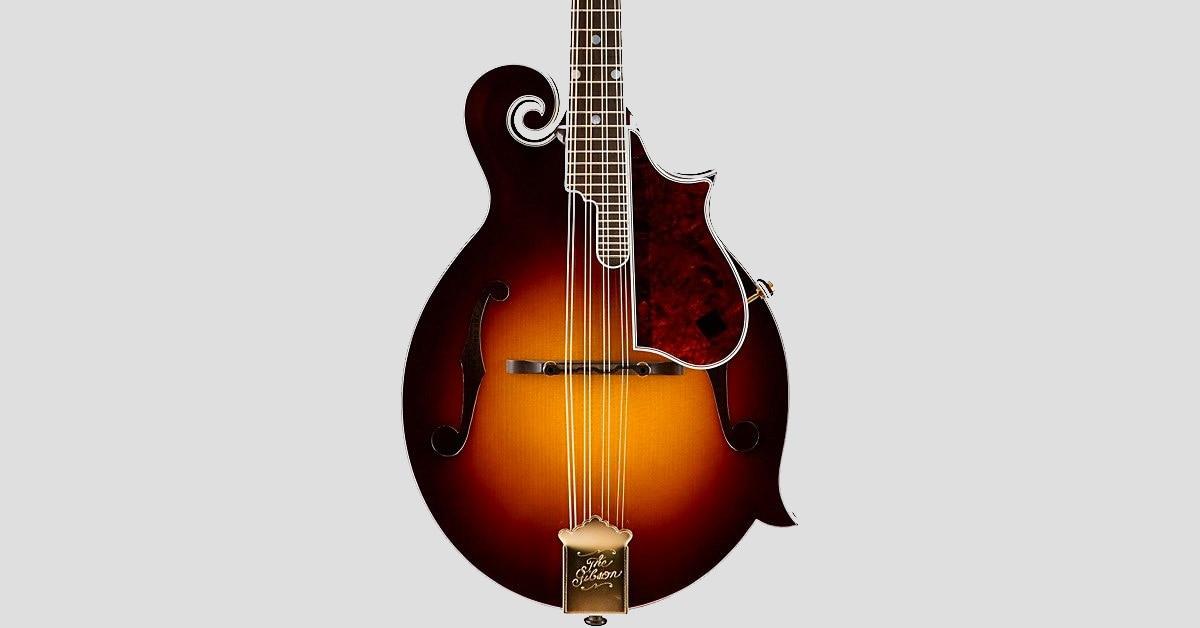If you’re shopping for a mandolin, you’ve arrived at the right place. With our huge selection of mandolins that ranges from affordable yet thoroughly playable starter mandolins to entirely handcrafted professional instruments, you’re sure to find the one that’s right for your music, skill level, and budget.
In this buying guide you’ll learn a little history of the mandolin, get to know the various body styles, and find out about the things to look for when choosing your mandolin. We’ll also offer some tips to help you get started playing the mandolin.
Table of Contents
How Much Should I Figure on Paying?
A Brief History of the Mandolin
Parts of the Mandolin
From A to F: Mandolin Body Styles
Mandolin Construction Methods and Woods
Electric Mandolins
Electrifying an Acoustic Mandolin
Mandolin Tuning
Mandolin Accessories
Getting Started Playing the Mandolin
Summing Up
How Much Should I Figure on Paying?
As with most things, you get what you pay for. You’ll find mass-produced mandolins made of laminates priced from under $100 to hand-crafted professional instruments with deluxe appointments and the highest grade tonewoods that carry price tags well north of $10,000. In between those extremes are dozens of moderately priced mandolins, most of which are completely playable and tonally satisfying. How much you should pay is a function of your budget, your commitment to mastering the mandolin, and your desire for certain features. As a general rule of thumb, buy the best instrument your budget allows for the best combination of playability, appearance, and sound.
Reading reviews by both the pros as well as fellow customers on Musician’s Friend’s website can help narrow your choices.
The Mandolin—A Brief History
Descendants of the lute family, today’s various mandolin types are mostly outgrowths of the Neapolitan mandolin, developed in Naples during the 18th century. Today’s bowl-back mandolins most closely resemble those early Italian instruments, and are popular with folk and classical musicians. In the mid 19th century, the mandolin fell out of favor, and its considerable repertoire of music was largely forgotten.
A resurgence of the mandolin’s popularity in the early 20th century led to the development of the various modern mandolin shapes and designs we know today. Much of this development happened in the U.S., when American luthiers began making flat-back and arched-top mandolins. Two pivotal figures were responsible for creating the modern mandolins we associate with bluegrass, country, blues, and jug-band music: Orville Gibson, and his acoustic engineer, Lloyd Loar. It was this pair who were responsible for the Florentine or F-style, and pear-shaped A-style mandolins that we know today. Most current acoustic mandolin models have a lineage that traces directly back to these instruments built by Gibson.
If Gibson/Loar were responsible for the designs of modern mandolins, it was a Kentuckian named Bill Monroe who defined the way the mandolin is played, at least where American roots music is concerned. The Loar-built F-5 mandolin Monroe bought in 1943 at a Florida barbershop would become the quintessential bluegrass mandolin, and Monroe’s playing style that combined fiddle-type leads with strong, percussive chording would become the gold standard for American country, bluegrass, and roots-music mandolinists.
Later, musicians would continue to expand the mandolin’s reach into other music forms. Notably, country performer Jethro Burns demonstrated the mandolin’s versatility, tackling jazz and Western swing tunes. Today, players like Chris Thile, David Grisman, Marty Stuart, Vince Gill, Sam Bush, and U. Srinivas continue to push the boundaries with their excursions into pop, rock, and even Indian Carnatic music.
Parts of the Mandolin
Because of its popularity we’ve chosen to illustrate the mandolin’s anatomy using an F-style instrument as an example. However, all commonly available acoustic mandolins share the same part names.
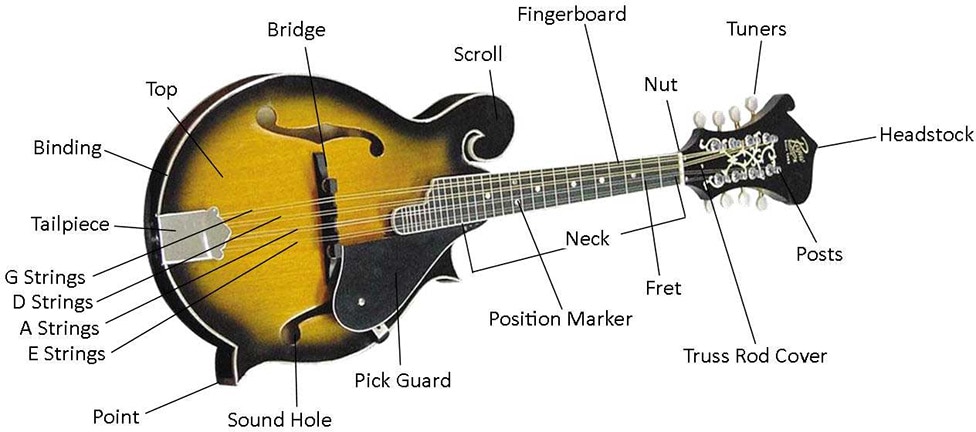
Headstock: also called the head or peghead, the tuning pegs are mounted to it.
Tuning pegs: also called tuning machines, machine heads, or tuners, they are geared mechanisms that hold the strings and are used to adjust string tension.
Nut: Also called the zero fret, it together with the bridge and tailpiece keeps strings in proper alignment.
Neck: It extends from the headstock to the body and sometimes contains a metal truss rod that adds strength and permits intonation adjustments.
Frets/fretboard or fingerboard: Glued to the neck, the fretboard has embedded metal frets. Pressing the strings onto the frets produces notes according to the frets’ positions.
Position markers: Often simple dots inlaid in the fretboard, but sometimes more ornate, they help orient the player’s fretting hand.
Body: Consists of the top, sides, and back. The top, also called the soundboard, is primarily responsible for producing the mandolin’s sound, and depending on the model may be flat, or arched similarly to a violin. Some mandolins have flat backs, others are bowl-shaped.
Scroll: Primarily decorative, it is only found on F-style mandolins.
Pickguard: Not all mandolins have this part designed to protect the body’s finish.
Sound hole: Shapes vary depending on the mandolin model. The illustrated type is an f-hole, but oval sound holes are also common, and provide the same function of projecting the mandolin’s sound.
Bridge: Made of wood, it transfers the strings’ vibrations to the mandolin’s top.
Tailpiece: Often made of ornately stamped or cast metal, it provides the anchor point for the strings.
From A to F: Mandolin Body Styles
While A-style and F-style mandolins are generally similar in tone, F-style models tend to be more popular among bluegrass and country artists. We’ll cover the details and differences among the most popular mandolin body styles here.
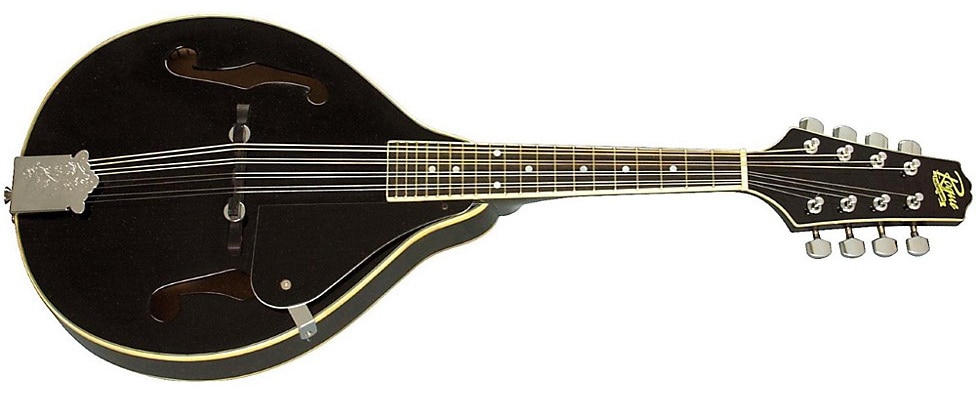
The Rogue RM-100A is a very affordable A-style mandolin that will give students on a budget a great start.
A-style mandolins: This is something of a catch-all term used to describe tear-shaped and oval-bodied mandolins that don’t otherwise fall under the the F-style or bowl-back categories. The term grew out of Gibson’s A-type mandolins produced in the early 20th century. Many have carved tops and backs with the back in some cases being arched like a violin. Somewhat confusingly though, A-style mandolins with arched backs are often described as having flat backs to differentiate them from bowl-back mandolins. Nowadays, some A-style models have more guitar-like profiles. Because they lack the fancy scrolls and points found on F-style mandolins, they are somewhat easier to build, and are therefore often less costly. A-style models tend to be popular with classical, folk, and Celtic musicians.
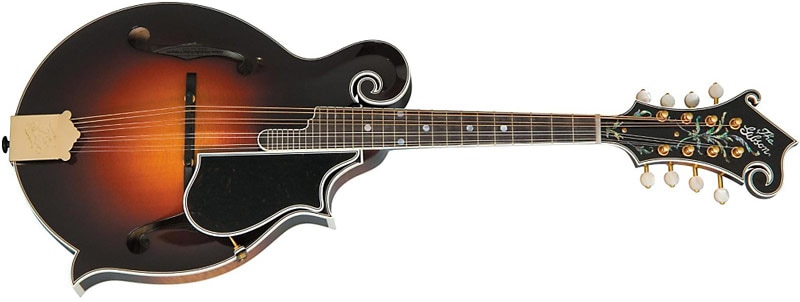
Gibson’s F-5L “The Fern” Mandolin is an exacting reproduction of the original created by Lloyd Loar and is coveted by the world’s best bluegrass mandolinists.
F-style mandolins: As we noted in our brief history above, Gibson produced the first F-style mandolins in the early 1900s. With their delicate body scroll and lavish appointments, they were the top of the Gibson line. The most renowned model was the F-5 designed by Gibson’s acoustic engineer, Lloyd Loar, and built under his supervision between 1924 and 1925. These instruments with Loar’s signature on their label are the world’s most sought-after mandolins and command huge prices today. Most modern F-style mandolins are often either exact replicas or similar-looking adaptations.They typically have the twin f-holes of the F-5 or a single oval sound hole. Most F-style models have body points on the lower side of the instrument that both subtly influence tone and provide a convenient resting point on the seated player’s thigh. Some modern luthiers and mandolin manufacturers have created offshoots that borrow some attributes from the original F-style models, but they have added their own modern touches. F-style mandolins, also sometimes called Florentine mandolins, are the first choice for most bluegrass, country, and roots-music musicians.
Bowl-back mandolins: With their rounded backs these mandolins more closely resemble their Italian forerunners as well as traditional lutes. They’re sometimes still referred to as Neapolitan mandolins because of the similarity to their Italian ancestors You’ll also see them referred to by the more countrified term “taterbugs.” High-quality bowl-back mandolins are popular with musicians who play classical, Baroque, renaissance, and other historical music styles. Due to the volume of their bodies, bowl-backs usually produce a deeper, rounder tone than other mandolin body types.
Mandolin Construction Methods and Woods
Far and away, spruce is the wood of choice in constructing mandolin tops, also called soundboards. Its dense grain provides the same bright and articulate response in mandolins that it produces in other stringed instruments such as guitars and violins. Spruce is unsurpassed in transmitting every nuance of the musician’s technique on the strings. Due to the scarcity and cost of high-quality spruce, some makers instead use cedar or mahogany that produce a somewhat deeper tone.
The best quality mandolins have soundboards hand-carved from solid pieces of spruce. Though many have arched tops, there are models with flat tops that are preferred by some players. Both types may have beautifully figured wood that adds to the instrument’s aesthetics—and cost. Book-matched tops are made from two pieces of wood whose grain lines are positioned so as to form an open book-like appearance where the two glued-together pieces meet.
Lower-cost mandolins often have laminate tops—several layers of wood pressed together. Laminates may have a thin veneer of attractively grained wood on top. Laminate tops are pressed into shape rather than being carved—a much less costly method that helps keep the mandolin’s price down. While solid spruce-topped mandolins are preferred by professional mandolinists, laminate-top mandolins are capable of producing very acceptable sound, and can be a good choice for the new player whose budget is tight.
Moderately priced mandolins may have a solid spruce top and a body made of laminated wood—a construction compromise that results in good tone while keeping the price tag down.
As with their cousin, the violin, better-quality mandolin bodies—composed of the sides (sometimes called the rims) and back—are usually made of solid maple. Koa, mahogany and other hardwoods are also sometimes used.
The fretboards of mandolins are usually made with rosewood or ebony—both very hard woods with a smooth surface that enables fast-fingered fretting. Necks are usually made with maple or mahogany for maximum rigidity. The neck is often made of two or more pieces of wood that are glued together. (Unlike tops, laminated necks are considered a plus.) Grain lines in the wood are often opposed to prevent warping or twisting. Most mandolin necks contain an embedded metal truss rod that allows neck adjustments to improve the instrument’s intonation and playability.
Unlike the bridge on many guitars, the mandolin bridge is not fastened to the top, instead being held in place by the strings. It is often made of either ebony or rosewood. As we’ll see below, electric mandolins may have a bridge that contains an electronic pickup that allows amplification of the mandolin.
Mandolin hardware includes the tuners, also called tuning machines or machine heads, and the tailpiece. Good-quality tuners with smooth-operating gears and solid construction are a must in order to tune the instrument and hold the strings in tune during performance. Well-designed tailpieces that hold the strings in place also can contribute to the instrument’s volume and sustain. They vary in design and are often elaborately decorated to enhance the mandolin’s visual appeal.
Mandolin cosmetics contribute little or nothing to the sound of the instrument, but can impact the value and pride of ownership. The most common cosmetic upgrades include fretboard and headstock inlays, often made of mother-of-pearl or abalone shell. Much of this inlay work is based on early historic mandolin motifs. The fern-like detailing on the the headstock of the revered Gibson F-5 is often mimicked.
The finishes used to protect the mandolin’s wood can subtly affect the sound of the instrument while also enhancing its look. Many F-style mandolins have finishes that resemble those used on violins. Thin nitrocellulose lacquer finishes are considered by many mandolin aficionados to offer the most transparent sound. That said, there are many other finishes used on mandolins including varnishes, stains, and polishes that aim to bring out the beauty of the woods without affecting the tonal quality or volume of the mandolin.
Electric Mandolins
Starting in the late 1920s, electric mandolins began making an appearance in the U.S. With their ability to be heard alongside much louder instruments in band settings, and the mobility they afforded onstage performers, their popularity has continued to grow. Gibson and Vega both introduced electric mandolin models in the 1930s. Later developments included 4- and 5-string models.
Though electric mandolins are usually played and tuned like their standard acoustic brethren, their body types can vary considerably. How they’re electrified also varies, some being equipped with pickups similar to those used on electric guitars, while others are essentially acoustic instruments with a pickup that transmits the mandolin’s output to an amplifier or sound system. We’ll look at the most common types here.
Semi-hollow electric mandolins: Like their semi-hollow guitar counterparts, they have a wood center block running through the body interior that helps tame the tendency to produce feedback that can be an issue with fully hollow electrified mandolins
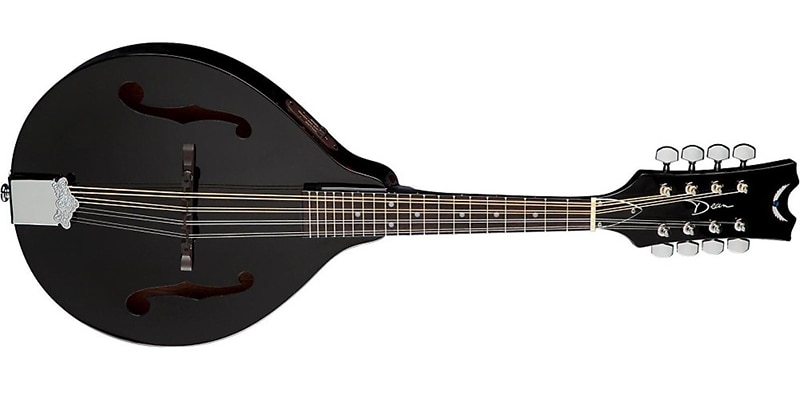
The budget-friendly Dean Tennessee Acoustic-Electric Mandolin makes it easy to plug in and play.
Acoustic-electric mandolins: These models typically resemble traditional acoustic mandolins, but incorporate a bridge-mounted piezo-electric pickup that converts the vibrations of the strings to electrical impulses. These electrical signals are routed through a preamplifier usually mounted on the top rim of the mandolin. The preamp increases the signal strength and sends it via a cable to an external amplifier or sound system. The preamp usually includes volume and tone controls, and may also include a built-in electronic tuner. Many performers prefer acoustic-electrics as an alternative to using a microphone in performance, since using a mic can cause feedback and keeps the player planted in one spot onstage.
Electrifying a Standard Acoustic Mandolin
There are a range of aftermarket pickups that can be used to electrify a standard acoustic mandolin. Most use a piezo-electric pickup element that is embedded in a bridge designed to replace the acoustic mandolin’s original bridge. Some designs require the use of a preamp. There are also magnetic pickups available that are designed to be used with small stringed instruments such as violins and mandolins. Installing any of these electronic options is likely to require the services of a professional.
Mandolin Tuning
Standard 8-string mandolins have four courses, each with 2 adjacent strings that are usually tuned in unison. This gives the mandolin its distinctive chiming sound. By far the most common tuning is the same scheme used on violins: G-D-A-E. There are other tunings occasionally used in which string pairs are tuned to different pitches to create “cross-tuning.” It’s also possible to tune a mandolin to match some of the intervals found on a guitar, offering a more familiar feel for guitarists.
Mandolin Accessories
Well-chosen accessories for the mandolin will enhance your playing experience and help to protect your investment. These include:
Mandolin straps: This is a necessity if you plan to play standing up. There are many choices of materials and looks to suit your personal taste.
Mandolin capos: This device clamps on the fretboard allowing you to raise the overall pitch of the mandolin so you can play songs in keys that are higher than those they were written in. This can be especially useful for singers whose vocal range is higher than the song’s usual key. Capos are available to fit the mandolins neck.
Mandolin cases and gig bags: Protect your mandolin from scrapes and scratches; they’re pretty much essential if you plan to take your mandolin on the road or to gigs.
Picks: Mandolin players use a variety of types including those made specifically for the mandolin as well as guitar picks.
Strings: Sooner or later you’ll need to change your mandolin’s strings. A fresh set can revive the tone of a mandolin that seems to have lost its luster. Strings are made using various materials, each with their own tonal characteristics. Experimenting with several types can help you find a tone that’s more pleasing and brings out the innate beauty of your mandolin’s sound.
Tuner: A good-quality tuner will make the process of tuning up your mandolin much easier. Some models have a specific mode for tuning mandolins that makes the process even simpler.
Dig deeper with our Mandolin String Buying Guide.
Getting Started Learning to Play the Mandolin
While having a friend or professional teacher show you the ropes is invaluable, nowadays there are a lot of resources available to get you started playing the mandolin on your own. These include:
Mandolin Instructional Books, Tutorials, DVDs, and CDs
You’ll find a huge range of resources to match your mandolin expertise, whether you’re an absolute beginner, intermediate student, or seasoned player looking to improve your skills. Many mandolin how-to’s and tutorials include DVDs and CDs with all kinds of audio and video examples of the techniques being taught. Some also include access to online resources where you can post questions and chat with other mandolin students, teachers, and enthusiasts. Many of these mandolin instructional books and media are focused on specific music styles such as bluegrass, country, or folk.
Mandolin Songbooks, Chord Guides, and Easy Tab Arrangements
With dozens of titles to choose from, you’ll find all the songs and music styles you love represented. Many offer simple arrangements of popular songs that are easy for beginners to learn. There are also numerous mandolin songbooks and learning tools written by the pros you admire, offering their tips and tricks for creating great music on the mandolin.
Explore Musician’s Friends huge selection of mandolin instruction books, tutorials, CDs, DVDs and songbooks.
Summing Up
You should now have some good basic information about the kinds of mandolins out there as well as the things to look for in shopping for a mandolin. There is no simple formula in arriving at the best instrument for your needs and budget. Your fingers and ears should be the ultimate judge.
One basic suggestion is to shop for the best instrument that falls within your budget. A poorly made mandolin that’s hard to play and tune is likely to discourage even the most determined student.
Reading professional and online reviews of various mandolin models can be helpful in pinpointing the right instrument. You’ll also find hundreds of user reviews from fellow musicians and mandolin students alike as you peruse our vast collection of mandolins.
We want you to be totally pleased with your new mandolin and offer 45-day, no-hassle returns (10 days on mandolins priced at $1999 or more).
After reading this guide, if you’re still not sure what mandolin is right for you, we invite you call to one of our friendly and knowledgeable Gear Heads at (877) 880-5907.





































































































































